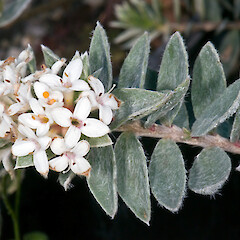Pimelea mimosa
Common name
pimelea
Synonyms
None - first described in 2011
Family
Thymelaeaceae
Flora category
Vascular – Native
Endemic taxon
Yes
Endemic genus
No
Endemic family
No
Structural class
Trees & Shrubs - Dicotyledons
Current conservation status
The conservation status of all known New Zealand vascular plant taxa at the rank of species and below were reassessed in 2017 using the New Zealand Threat Classification System (NZTCS) – more information about this can be found on the NZTCS website. This report includes a statistical summary and brief notes on changes since 2012 and replaces all previous NZTCS lists for vascular plants.
Please note, threat classifications are often suggested by authors when publications fall between NZTCS assessment periods – an interim threat classification status has not been assessed by the NZTCS panel.
- Conservation status of New Zealand indigenous vascular plants, 2017 . 2018. Peter J. de Lange, Jeremy R. Rolfe, John W. Barkla, Shannel P. Courtney, Paul D. Champion, Leon R. Perrie, Sarah M. Beadel, Kerry A. Ford, Ilse Breitwieser, Ines Schönberger, Rowan Hindmarsh-Walls, Peter B. Heenan and Kate Ladley. Department of Conservation. Source: NZTCS and licensed by DOC for reuse under the Creative Commons Attribution 4.0 International licence.
2017 | Threatened – Nationally Critical | Qualifiers: CD, OL
Previous conservation statuses
2012 | Threatened – Nationally Critical | Qualifiers: OL, RF
2009 | Threatened – Nationally Critical
Brief description
Low growing sprawling shrub with hairy twigs bearing pairs of narrow pointed hairy leaves, hairy white flowers and red fruit inhabiting Te Mata peak in the Hawkes Bay. Leaves pointing out from stem, 9-20mm long by 2.5-5mm wide, hairs glisten.
Distribution
Endemic. New Zealand: North Island, Hawke’s Bay (Te Mata peak)
Habitat
On exposed limestone ridge and cliffs and scree slopes below them.
Detailed description
Procumbent to decumbent medium- sized shrubs to 250 mm high, with stems to 500 mm long. Branching mainly sympodial. Young branchlets brown, densely covered by moderately long, white hairs. Internodes 2-6 mm long; older stems glabrate, brown to grey-brown. Node buttresses short (0.2 mm), lunate, masked by hairs on young branchlets, not prominent on leafless stems. Leaves decussate, on short petioles (0.5-1.0 mm), ascending at first, soon becoming patent or deflexed, persistent. They may appear to be distichous on appressed branches. Lamina to 9.0-20.0 × 2.5-5.0 mm, varying in width from plant to plant, medium green, adaxially concave or slightly keeled, elliptic to narrow-elliptic, acute, base cuneate; both surfaces of young leaves uniformly densely covered by short, glistening, white, appressed hairs. Mid-vein usually not evident. Older leaves become glabrate and appear dull-green. Stomata on both surfaces. Inflorescences terminal, 2-7-flowered, compact. Involucral bracts 4, the same size as, or slightly wider than, adjacent leaves (9-12 × 4-6 mm) partly hiding the flowers. Receptacle densely covered in short hairs. Plants gynodioecious. Flowers white, on short (0.5 mm) pedicels, densely hairy outside, inside hairless. Female tube 4 mm long, ovary portion 3 mm, calyx lobes 2.0 × 1.2 mm; hermaphrodite tube 6 mm long, ovary portion 2 mm, calyx lobes 2.5 × 2.0 mm. Anther dehiscence introrse. Ovary sparsely hairy at summit. Fruits ovoid, fleshy, red, 5.0-6.0 × 3.5-4.0 mm. Seeds narrow-ovoid, 3.2 × 2.0 mm, crest thin.
Similar taxa
Allied to Pimelea barbata from which it is distinguished by the leaves which are up to 22 mm long. Pimelea mimosa is geographically isolated (allopatric) from both P. barbata subspecies, and is one of two taxa now known to be endemic to Te Mata Peak - the other is Chionochloa flavicans f. temata.
Flowering
December - June
Flower colours
White
Fruiting
January - July
Propagation technique
Easily propagated from semi-hardwood cuttings and layered pieces. An excellent rockery plant which flourishes in a sunny, well drained rich soil. Intolerant of water logging. The species is known to tolerate moderate competition and humidity as well as both full sun and light shade where is has been cultivated around Auckland and the Waikato. Cultivation (at least in the short term) may be all that prevents this species from extinction
Threats
Listed by de Lange et al.(2009) in Appendix 2 as Taxonomically Indeterminate/Nationally Critical Pimelea aff. aridula (a) (CHR 282959; Te Mata Peak) qualified OL (one Location) and RF (Recruitment Failure). Pimelea mimosa Burrows (2011) stated that this species is now extinct in the wild and survives only in cultivation. However, recently (2011) Pimelea mimosa was confirmed as still present on Te Mata Peak by NZPCN member Philip Smith. Although this is good news there is good data to show that the Te Mata peak population of this species has been in serious decline for many years, due to fires, weed invasion and over-collecting (ironically) by botanists.
Etymology
pimelea: Pimeleoides means “resembling Pimelea’’, a genus in the family Thymelaeaceae (Greek, -oides = resembling, like).
mimosa: Derived from the Greek word mimos: meaning ‘mimic’. Probably given in allusion to the similarity of this species to Pimelea barbata.
Attribution
Fact sheet prepared for NZPCN by P.J. de Lange (4 October 2011).
References and further reading
Burrows, C.J. 2011: Genus Pimelea (Thymelaeaceae) in New Zealand 5. The taxonomic treatment of five endemic species with both adaxial and abaxial leaf hair. New Zealand Journal of Botany 49: 367-412.
de Lange, P.J.; Norton, D.A.; Courtney, S.P.; Heenan, P.B.; Barkla, J.W.; Cameron, E.K.; Hitchmough, R.; Townsend, A.J. 2009: Threatened and uncommon plants of New Zealand (2008 revision). New Zealand Journal of Botany 47: 61-96.
NZPCN Fact Sheet citation
Please cite as: de Lange, P.J. (Year at time of access): Pimelea mimosa Fact Sheet (content continuously updated). New Zealand Plant Conservation Network. https://www.nzpcn.org.nz/flora/species/pimelea-mimosa/ (Date website was queried)








